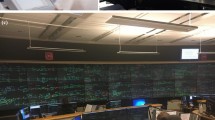Abstract
Maritime traffic is a distributed, self-organising system. When resources are abundant, this has proven to be successful. However, near ports navigation space becomes limited, decreasing manoeuvring space, which has a negative effect on efficiency and safety. This article discusses how arrival management, realising efficiency and safety, can be modelled in the maritime domain using a functional approach. This management system needs to fit the requirements set by the maritime domain: large mass, small safety margins, and complex ship control. The main focus will be on resilience to ensure safety at all times and on control to realise efficiency.






Similar content being viewed by others
References
Ashby WR (1956) An introduction to cybernetics. Wiley, New York, USA
Bisantz AM, Roth E, Brickman B, Gosbee LL, Hettinger L, McKinney J (2003) Integrating cognitive analyses in a large-scale system design process. Int J Hum Comput Stud 58:177–206
Burns CM, Bryant DJ, Chalmers BA (2005) Boundary, purpose, and values in work-domain models: models of naval command and control. IEEE Trans Syst Man Cybern: part A 35(5):603–616
Conant RC, Ashby WR (1970) Every good regulator of a system must be a model of that system. Int J Syst Sci 1(2):89–97
Holling CS (1996) Engineering resilience versus ecological resilience. In: Schulze PC (ed) Engineering within ecological constraints. National Academy Press, Washington
Hollnagel E (2012) FRAM: the functional resonance analysis method. Ashgate Publishing Ltd, Farnham
Kalman RE, Bucy RS (1961) New results in linear filtering and prediction theory. Trans ASME Basic Eng 83:95–107
Marca DA, McGowan CL (1987) Structured analysis and design technique. McGraw-Hill, New York
National Research Council (1994) Minding the helm: marine navigation and piloting. National Academy Press, Washington
Nuutinen M, Savioja P, Sonninen S (2007) Realising present, acknowledging the past, and envisaging the future: challenges of developing the complex socio-technical system of VTS. Appl Ergon 38:513–524
Papenhuijzen, B (1994) Towards a human operator model of the navigator. Ph.D. thesis, Delft University of Technology, Delft, Netherlands
Rasmussen J (1986) Information processing and human-machine interaction. North-Holland, Elsevier, Amsterdam
Rasmussen J (1997) Risk management in a dynamic society: a modelling problem. Saf Sci 27(2/3):183–213
Rasmussen J (1999) Ecological interface design for reliable human-machine systems. Int J Aviat Psychol 9(3):203–223
Sheridan TB (1992) Telerobotics, automation and human supervisory control. MIT Press, Cambridge
Smallwood RD (1967) Internal models and the human instrument monitor. IEEE Trans Hum Factors Electron HFE 8(3):181–187
Stassen HG, Johannsen G, Moray N (1990) Internal representation, internal model, human performance model and mental workload. Automatica 26:811–820
Van Westrenen F (1999) The maritime pilot at work: evaluation and use of a time-to-boundary model of mental workload in human–machine systems. Ph.D. thesis, Delft University of Technology, Delft, The Netherlands
Van Westrenen F, Praetorius G (2012) Maritime traffic management: a need for central coordination? Cogn Technol Work. doi:10.1007/s10111-012-0244-5
Veldhuyzen W (1976) Ship manoeuvring under human control: analysis of the helmsman’s control behaviour. Ph.D. thesis, Delft University of Technology, Delft, Netherlands
Walker B, Holling CS, Carpenter SR, Kinzig A (2004) Resilience, adaptability and transformability in social–ecological systems. Ecol Soc 9(2):5
Woods D (2006) Essential characteristics for resilience. In: Hollnagel E, Woods D, Leveson N (eds) Resilience engineering: precepts and concepts. Ashgate Publishing Group, Abingdon, pp 21–34
Acknowledgments
The author would like to thank John Flach for his comments on an early version of this paper. He would also like to thank the reviewers for their constructive comments. Finally, this paper would not have been possible without the Dutch Pilots providing insight into their work.
Author information
Authors and Affiliations
Corresponding author
Rights and permissions
About this article
Cite this article
van Westrenen, F. Modelling arrival control in a vessel traffic management system. Cogn Tech Work 16, 501–508 (2014). https://doi.org/10.1007/s10111-014-0279-x
Received:
Accepted:
Published:
Issue Date:
DOI: https://doi.org/10.1007/s10111-014-0279-x




